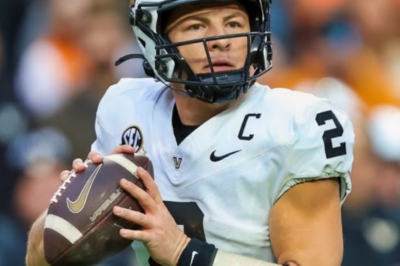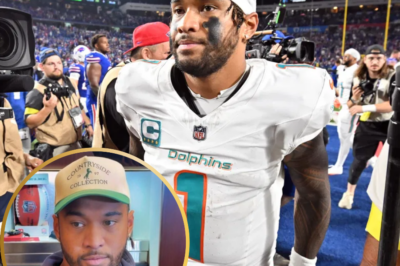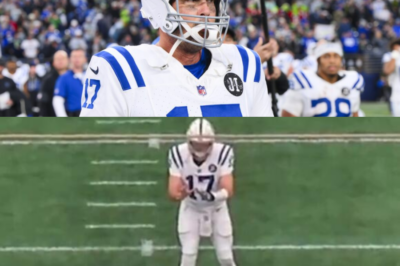VIDEO: Arizona Cardinals star player stretchered off after a terrifying neck injury. The entire stadium fell silent.
The air in Lucas Oil Stadium, typically a cacophony of organized chaos on a game day, was stolen. The relentless roar of the crowd, the shrill whistles, the thunderous collisions in the trenches—all of it vanished, replaced by a profound, unsettling silence that seemed to swallow the entire arena.
On the synthetic green turf, under the glaring lights that now felt more like a surgical lamp than a source of spectacle, lay the motionless body of [Player’s Name], the Arizona Cardinals’ electrifying [Position], whose very presence on the field was a promise of highlight-reel plays and unbridled athleticism.
This was no longer a game between the Arizona Cardinals and the Indianapolis Colts; it was a collective, gut-wrenching vigil.
The phrase “carted off with a neck injury” flashed across news wires and social media feeds, a clinical description for a scene that was anything but.
It was a moment that transcended rivalry, a stark reminder of the fragile line these modern-day gladiators walk every Sunday, where a single, routine play can mutate into a life-altering event.
This article is not merely a report on an injury. It is a deep dive into the anatomy of that terrifying moment, its immediate aftermath, the complex medical protocols that swing into action, the long and uncertain road to recovery, and the profound impact such events have on a team, a league, and the very soul of a sport we love.

A Routine Act Turned Nightmare
To understand the gravity of the incident, we must first reconstruct the context.
The game against the Indianapolis Colts was a pivotal one for the Cardinals. Sitting at a [Record, e.g., 2-4] record, every snap carried the weight of their season’s potential.
[Player’s Name], in his [Number, e.g., third] year, had emerged as the lynchpin of the Cardinals’ offense—a dynamic [Position, e.g., wide receiver] known for his blistering speed, razor-sharp route running, and a fearlessness over the middle that both inspired teammates and terrified coaches.
The play call was a familiar one: “All Go,” a concept designed to stretch the defense vertically.
[Quarterback’s Name] took the snap from the shotgun, his eyes scanning the field as the pocket began to collapse. [Player’s Name], lined up in the slot, executed a swift stutter-step to gain inside leverage on the Colts’ defensive back and burst into his route down the seam.
It was a throw [Quarterback’s Name] had made a hundred times in practice—a laser beam into a tight window, relying on his receiver’s trust and timing.
The ball left the quarterback’s hand in a perfect spiral. [Player’s Name], tracking the pass over his shoulder, extended his body, a picture of supreme athletic focus.
What happened next was a blur of converging forces. As he leaped for the catch, Colts’ safety [Defensive Player’s Name], arriving at full speed in a textbook coverage rotation, also launched himself to break up the pass. Their trajectories intersected not with a clean, shoulder-to-shoulder impact, but at a devastatingly awkward angle.
The primary point of contact was not [Player’s Name]’s torso or limbs, but the crown of his helmet, driving directly into the side of his neck and head as he was in a vulnerable, extended position.
The sickening sound of the collision—a dull, percussive thud that was audibly different from the usual pad-crunching hits—echoed in the sudden hush that fell over the stadium.
[Player’s Name] collapsed immediately, his body going limp before he even hit the ground. The ball, an insignificant afterthought, fell harmlessly to the turf.
The Sideline Becomes an ER: The Critical First Minutes
In the stands and in living rooms across the country, the world froze. On the field, it accelerated into a well-rehearsed, high-stakes ballet of emergency medicine. This is where the cold, hard reality of the NFL’s health and safety protocols takes over, a world far removed from fantasy football stats and playoff predictions.
The First Responders: Athletic Trainers and Team Physicians
Before the referees could even blow their whistles to stop the play, Arizona Cardinals Head Athletic Trainer [Trainer’s Name] and his team were already sprinting onto the field. Their speed is not born of panic, but of drilled precision. Their first and only priority: the athlete’s spinal integrity. The initial assessment is swift and terrifyingly clinical. [Player’s Name] was not moving. The cardinal rule in such situations is to assume a cervical spine injury until proven otherwise.
The medical team’s actions were a synchronized display of expertise. They immediately stabilized [Player’s Name]’s head and neck, holding his cervical spine in a neutral position to prevent any potential exacerbation of an injury. They spoke to him in calm, measured tones: “[Player’s Name], can you hear me? Don’t move. We’re here with you. Squeeze my hand if you can hear me.” The absence of a response, or a lack of motor function, would confirm their worst fears. Players from both teams, recognizing the severity, took a knee. The collective gaze of tens of thousands was fixed on that small circle of medical personnel, their bodies forming a protective shield around their fallen teammate.
The Stabilization Process: The Spine Board and the Cart
Within moments, the “spine board” and a cervical collar were brought onto the field. The process of log-rolling an injured player onto the board is a delicate, multi-person maneuver that requires absolute coordination. Every second feels like an eternity for those watching. As they secured him, the stadium’s Jumbotron, in a move of increasing common practice, wisely refrained from showing close-ups, instead panning to the concerned faces on the sideline or the team owners in their suites.
Once fully immobilized on the backboard, [Player’s Name] was carefully lifted onto the motorized cart that had driven onto the field—the very image that would become the defining, chilling visual of the day. The sight of a powerful athlete, a symbol of strength and vitality, rendered immobile and being driven off the field of play is one of the most disquieting in all of sports. As the cart began its slow, solemn journey towards the tunnel, a remarkable thing happened. Players from both the Cardinals and the Colts approached, offering words of encouragement, pats on the chest, a show of unified support. The Colts’ fans, in a display of pure class, rose to their feet and began a sustained, heartfelt applause—not for a play, but for a person.
The Aftermath: A Team, a League, and a Family in Limbo
The game eventually resumed, but the competitive fire had been extinguished, replaced by a somber sense of duty. The final score became a trivial footnote. The real drama had shifted to the local Indianapolis hospital where [Player’s Name] had been transported via ambulance for immediate and advanced imaging and evaluation.
The Human Element: Emotional Toll on Teammates and Coaches
In the Cardinals’ locker room after the game, the mood was funereal. Head Coach [Coach’s Name], a man known for his stoic demeanor, faced the media with red-rimmed eyes and a voice thick with emotion. “Football is a game we love,” he stated, his words measured and heavy. “But it’s just a game. Right now, our thoughts, our prayers, our entire focus is on [Player’s Name] and his family. He’s more than a player to us; he’s our brother. We’re a family, and when one of us hurts, we all hurt.”
Teammates echoed this sentiment. Veteran leaders like [Veteran Player’s Name] spoke of the difficulty in refocusing. “You try to lock in, but your mind is with your brother. You’re thinking about his wife, his kids. It puts everything into perspective real quick.” This emotional whiplash—the requirement to be a violent competitor one moment and a compassionate human being the next—is a psychological challenge for which no playbook can prepare an athlete.
The Medical Deep Dive: Understanding Cervical Spine Injuries
For the public, a “neck injury” is a vague and frightening term. From a medical perspective, the possibilities range from the less severe to the catastrophic.
Cervical Stingers/Burners: A common injury involving a stretching or compression of the brachial plexus nerves, causing a burning or stinging sensation down the arm. While painful, they are often temporary.
Herniated Discs: Damage to the cushioning discs between the vertebrae, which can press on nerves and cause pain, weakness, or numbness.
Vertebral Fractures: A break in one of the seven cervical vertebrae. The severity depends entirely on the location and whether the spinal cord is involved.
Spinal Cord Contusion (Bruising) or Transection (Severing): This is the worst-case scenario. Bruising or damage to the spinal cord itself can lead to temporary or permanent loss of function, sensation, and movement below the level of the injury.
The immediate goal of the medical team is to prevent a “secondary injury”—further damage caused by movement of an unstable spine. The administration of corticosteroids to reduce inflammation, advanced MRI and CT scans to get a precise picture of the damage, and consultations with neurosurgeons and orthopedic specialists are all part of the critical first 24 hours.
The Long Road Ahead: Rehabilitation, Recovery, and the Question of “What Next?”
The journey from a hospital bed back to any form of normalcy is a marathon, not a sprint. It is a path paved with uncertainty, grueling physical therapy, and profound mental fortitude.
Phases of Rehabilitation:
Initial Immobilization: The first step is often complete rest and immobilization of the neck using a rigid brace to allow any fractures or ligament damage to begin healing.
Physical Therapy: Once cleared by surgeons, a carefully supervised PT regimen begins. This starts with isometric exercises to maintain muscle tone without moving the neck, gradually progressing to range-of-motion exercises and strength training.
Functional Training: This phase involves reintegrating the body’s movements, relearning coordination, and preparing the body for the demands of daily life—and potentially, for a return to sport.
The Psychological Battle:
The mental and emotional trauma of such an event cannot be overstated. An athlete’s identity is intrinsically tied to their physical prowess. To have that foundation shaken by a sudden, violent injury can lead to anxiety, depression, and Post-Traumatic Stress Disorder (PTSD). The fear of re-injury, the frustration of physical limitations, and the existential question of life beyond football are battles fought in the quiet moments away from the public eye. Access to sports psychologists and a strong support system from family, friends, and the team are invaluable.
The NFL’s Evolving Safety Landscape
An incident like this inevitably reignites the ongoing debate about player safety in the NFL. The league has made significant strides in recent years:
The “Heads Up” Football Initiative: Teaching proper tackling techniques to avoid using the crown of the helmet.
Rule Changes: Penalizing and fining players for helmet-to-helmet hits and targeting defenseless players.
Advanced Equipment: The continued development and adoption of improved helmet technology, like the VICIS helmet, which ranks high in reducing the severity of impacts.
Yet, as long as the game is played at this speed and with this level of force, the risk of catastrophic injury can never be entirely eliminated. It is an inherent part of the sport’s DNA. Each scary scene forces the league, teams, and players to re-evaluate this risk-reward calculus.
A Community United in Hope
In the days following the injury, an outpouring of support flooded social media. The hashtag [#PlayerNameStrong, e.g., #KylerStrong] began trending nationally. Fans, fellow NFL players from across the league, and even teams in other sports sent messages of encouragement. This digital vigil is a testament to the community that exists around sports—a community that, at its best, rallies around its heroes in their most vulnerable moments.
The Arizona Cardinals organization released a statement confirming that [Player’s Name] had sustained a cervical spine injury, was alert and under the care of world-class specialists, and had movement in his extremities—a piece of news that was met with a collective sigh of relief across the football world. While the long-term prognosis remains unknown, that initial update provided a flicker of hope.
More Than a Game
The image of [Player’s Name] being carted off the field in Indianapolis will be seared into the memory of everyone who witnessed it. It was a shocking, sobering, and profoundly human moment. It forced us to look past the jerseys, the contracts, and the statistics, and see the individual whose body had borne the ultimate cost of the spectacle we so passionately consume.
His journey is now beginning—a journey of healing, of resilience, and of redefinition. Whether his path leads him back to the gridiron or toward a new chapter in his life, his courage will be an inspiration. The silence in Lucas Oil Stadium that day was not a sign of absence, but a powerful presence—a collective prayer, a moment of shared fear, and a stark reminder that within the brutal, beautiful theater of professional football, the most impactful stories are often those of the human spirit facing its greatest challenges. The Cardinals, and the entire NFL family, will be watching, waiting, and hoping for the recovery of their star, a recovery that means infinitely more than any win or loss.
News
Heisman Trophy Voter Responds Sharply to Vanderbilt QB Diego Pavia’s Controversial “F–k The Voters” Statement
Heisman Trophy Voter Responds Sharply to Vanderbilt QB Diego Pavia’s Controversial “F–k The Voters” Statement In the world of college…
VIDEO: Joe Burrow just said the UNTHINKABLE about a potential Bengals blockbuster trade. Fans are FLOORED.
VIDEO: Joe Burrow just said the UNTHINKABLE about a potential Bengals blockbuster trade. Fans are FLOORED. In the ever-evolving landscape…
This is NOT a drill: Diego Pavia just publicly made his move on Tate McRae AGAIN, and his true colors are on full display. You won’t believe what he did.
This is NOT a drill: Diego Pavia just publicly made his move on Tate McRae AGAIN, and his true colors…
TUA EXPLODES! Dolphins QB breaks silence on brutal benching with fiery response no one expected. You HAVE to hear what he said.
TUA EXPLODES! Dolphins QB breaks silence on brutal benching with fiery response no one expected. You HAVE to hear what…
This video will DESTROY everything you remember about Philip Rivers’ final season. The first clip back is absolutely SAVAGE.
This video will DESTROY everything you remember about Philip Rivers’ final season. The first clip back is absolutely SAVAGE. In…
Tua Tagovailoa’s Unexpected Sideline Behavior During Dolphins’ Heavy Loss to Steelers Caught on Camera — Teammates’ Reactions Speak Volumes
Tua Tagovailoa’s Unexpected Sideline Behavior During Dolphins’ Heavy Loss to Steelers Caught on Camera — Teammates’ Reactions Speak Volumes In…
End of content
No more pages to load

![Arizona Cardinals Star Carted Off With Neck Injury vs. Indianapolis Colts In Scary Scene [VIDEO] - NewsBreak](https://img.particlenews.com/image.php?type=thumbnail_580x000&url=4HxXqb_15apN0Gn00)











